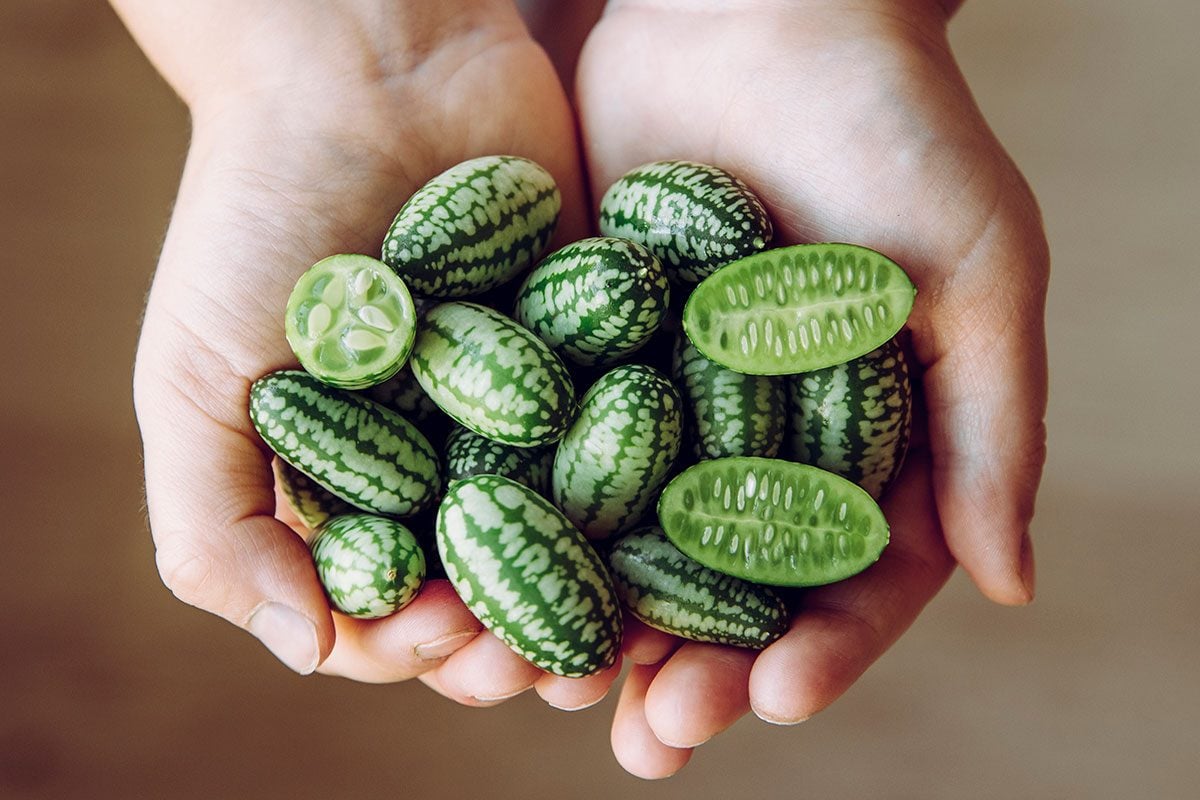
What is a cucamelon? Imagine a tiny watermelon with the taste of a cucumber and a hint of lime. That's a cucamelon! These adorable fruits, also known as Mexican sour gherkins, are about the size of a grape. They grow on vines and are native to Mexico and Central America. Cucamelons are not only cute but also packed with nutrients. They are rich in fiber, vitamins, and antioxidants. Perfect for snacking, adding to salads, or pickling, cucamelons bring a unique twist to your meals. Curious about more cucamelon facts? Let's dive into 20 surprising details about this fascinating fruit!
Key Takeaways:
- Cucamelons are tiny fruits that look like miniature watermelons but taste like cucumbers with a hint of lime. They are easy to grow, resistant to pests, and can be a fun addition to salads or pickled for a tangy crunch.
- Cucamelons are low in calories, high in fiber, and packed with essential nutrients like vitamin C, potassium, and magnesium. They are a great snack for maintaining a healthy weight and promoting gut health.
What is a Cucamelon?
Cucamelons, also known as Mexican sour gherkins or mouse melons, are tiny fruits that look like miniature watermelons but taste like cucumbers with a hint of lime. These unique fruits have been gaining popularity for their delightful appearance and refreshing flavor. Let's dive into some fascinating facts about cucamelons.
-
Cucamelons are native to Mexico and Central America. They have been cultivated in these regions for centuries, often used in traditional dishes and as a refreshing snack.
-
The scientific name for cucamelon is Melothria scabra. This name reflects their botanical classification and helps distinguish them from other similar fruits.
-
Cucamelons are not genetically modified. Despite their unusual appearance, they are a naturally occurring fruit that has been selectively bred over time.
-
They are also known as "sandiitas" in Spanish. This translates to "little watermelons," a fitting name given their appearance.
Growing Cucamelons
Growing cucamelons can be a rewarding experience for gardeners. They are relatively easy to cultivate and can thrive in various climates. Here are some interesting facts about growing cucamelons.
-
Cucamelons are drought-tolerant. They can survive with minimal water, making them an excellent choice for regions with dry climates.
-
They prefer well-drained soil. Ensuring the soil is not too compacted will help cucamelons grow more effectively.
-
Cucamelons can be grown in containers. This makes them a versatile option for those with limited garden space.
-
They are resistant to many common pests. This resilience makes them a low-maintenance crop for gardeners.
Culinary Uses of Cucamelons
Cucamelons are not only fun to grow but also versatile in the kitchen. Their unique flavor and texture make them a delightful addition to various dishes. Here are some culinary facts about cucamelons.
-
Cucamelons can be eaten raw. Their crisp texture and refreshing taste make them a perfect snack straight from the vine.
-
They are often used in salads. Adding cucamelons to salads provides a burst of flavor and a visually appealing element.
-
Cucamelons can be pickled. Their small size and firm texture make them ideal for pickling, adding a tangy crunch to any meal.
-
They pair well with seafood. The citrusy undertones of cucamelons complement the flavors of many seafood dishes.
Nutritional Benefits of Cucamelons
Cucamelons are not just tasty; they also offer several health benefits. Packed with essential nutrients, they can be a valuable addition to a balanced diet. Here are some nutritional facts about cucamelons.
-
Cucamelons are low in calories. This makes them an excellent snack for those looking to maintain a healthy weight.
-
They are high in fiber. Consuming cucamelons can aid in digestion and promote gut health.
-
Cucamelons contain antioxidants. These compounds help protect the body from oxidative stress and support overall health.
-
They are a good source of vitamins and minerals. Cucamelons provide essential nutrients like vitamin C, potassium, and magnesium.
Fun Facts About Cucamelons
Cucamelons have some quirky and fun aspects that make them even more intriguing. Here are a few fun facts to round out our list.
-
Cucamelons are often mistaken for mini watermelons. Their appearance can be quite deceiving, leading to some amusing mix-ups.
-
They have a long growing season. Cucamelons can produce fruit from late spring until the first frost, providing a steady supply of these delightful fruits.
-
Cucamelons are popular in gourmet cuisine. Many chefs use them to add a unique twist to their dishes.
-
They can be grown as ornamental plants. Their attractive vines and tiny fruits make them a charming addition to any garden.
The Tiny Wonder of Cucamelons
Cucamelons, also known as Mexican sour gherkins, pack a punch in both flavor and nutrition. These tiny fruits resemble mini watermelons but taste like cucumbers with a hint of lime. They’re not just cute; they’re versatile too. You can eat them fresh, pickle them, or toss them into salads for a zesty twist.
Growing cucamelons is pretty straightforward. They thrive in warm climates and need well-drained soil. Once established, these plants are quite hardy and resistant to pests. Plus, they’re a great conversation starter in any garden.
Nutritionally, cucamelons are low in calories but high in vitamins and antioxidants. They’re a healthy snack option that can add variety to your diet. So, next time you’re looking for something unique to grow or eat, give cucamelons a try. You won’t be disappointed!
Frequently Asked Questions
Was this page helpful?
Our commitment to delivering trustworthy and engaging content is at the heart of what we do. Each fact on our site is contributed by real users like you, bringing a wealth of diverse insights and information. To ensure the highest standards of accuracy and reliability, our dedicated editors meticulously review each submission. This process guarantees that the facts we share are not only fascinating but also credible. Trust in our commitment to quality and authenticity as you explore and learn with us.


